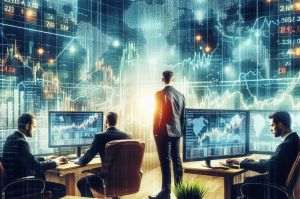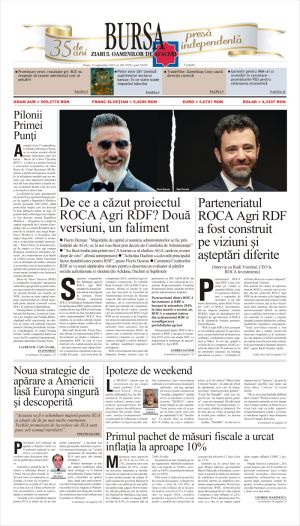Last year, the National Bank of Romania (BNR) missed both the inflation target as well as the consumer prices forecasts. The National Institute of Statistics (INS) announced yesterday an annual inflation rate of 4% last year.
In the opinion of Adrian Codiraşu, the CFA chairman, the inflation rate will continue along a downward trend: "According to the latest survey, this year inflation will reach about 3.5-4%. Risk factors include the price of oil, as well as the tensions in the East, but also the depreciation of the leu, of 2-4% per year, which is compatible with an inflation between 3.5% and 4%".
Adrian Codirlaşu pointed out that, for three years, we had an "extremely pro-cyclical" fiscal policy, and this led to increases of the current account and budget deficits. The specialist also told us: "This money went into consumption. As a result, demand increased and so did inflation. That is a consequence of pro-cyclical policies. The local economy was unable to cope with the excess demand, which was offset via consumption, via price increases and via trade deficit, which is at record levels".
Our country has the highest inflation rate in the EU, the largest budget deficit and the largest current account deficit, and all of those are "the result" of the pro-cyclical fiscal measures, Mr. Codirlaşu said, who feels that, in order to rectify the situation, the Government should first of all take some fiscal measures.
"The policy will probably remain pro-cyclical, as it will be difficult to move to an anti-cyclical one. Fiscal measures to reduce the deficit should be taken. Cutting the interest rate, although it would cause the inflation to drop, would also slow down the economy and increase the leu's spread against the euro. This is the risk of adopting monetary measures and, consequently, it would be best to take fiscal measures".
According to economist Ionuţ Dumitru, former head of the Fiscal Council, an inflation rate of 4% in 2019 is not a surprise: "We were expecting to have further pressure on food prices in December, especially in terms of meat prices, amid the swine fever problem. The price of pork will probably continue to rise ". Ionuţ Dumitru told us that analysts expect slightly lower inflation this year compared to 2019, given that the excises were cut starting January 1st. At the same time, however, many uncertainties remain, generally related to the managed prices and the exchange rate. According to Ionuţ Dumitru, specialists estimate inflation at around 3% -3.5% at the end of the year.
The economist further explained: "In terms of monetary policy we do not expect any change, rather the policy rate being kept at its current level of 2.5%. We do not believe that the NBR will raise the policy rate, but neither will it cut it. Given that we still have fairly high inflation and fairly large imbalances in the economy, we could theoretically say that an interest rate hike would be needed. At the same time, given the international context where interest rates are rather declining in mature markets, it is likely that the NBR will not be able to raise the rate, nor cut it, as a result of the imbalances in the economy. As a result, the policy will be to keep the interest level unchanged".
The biggest increase in prices was recorded for foodstuffs, respectively 5.08%, in December compared to November. The biggest price increases were seen for potatoes (23.61%), fresh fruit (18.41%), flour (5.19%). Over the same period, prices of non-food goods increased by 3.31% while services saw an increase of 4.16%.
National Statistics Institute (INS) figures show that the median consumer price rate, compared to 2018, was 3.8% when calculated based on the Consumer Price Index, and 3.9% when determined based on the Harmonized Index of Consumer Prices (IAPC).
The median monthly inflation rate last year compared to 2018 was 4.69% on foodstuffs, 3.24% for non-foodstuffs and 3.87% for services.
In November, the National Bank of Romania cut its inflation forecast for the end of last year to 3.8%, estimating an inflation of 3.1% for the end of 2020. In August 2019, the central bank predicted an inflation of 4.2% for 2019 and 3.4% at the end of December 2020..
NBR Governor Mugur Isarescu announced, at the time, that the annual inflation rate is expected to be outside the target range of 2.5%, with a margin of +/- 1%, at the end of 2019, mainly under the impact of non-volatile shocks from the first part of 2019. It would later reenter and stay in the upper half of the target range amid the exhaustion of the effects of the supply shock of 2019. The inflation rate will be influenced by the persistence of internal inflationary pressures at the level of basic inflation, according to the head of the NBR.
In the Eurozone, the annual inflation rate rose in December 2019, to 1.3%, compared to 1% in November, according to Eurostat estimates.
The increase in inflation in the Eurozone, in December, is mainly explained by the increase in food, alcoholic beverages and cigarettes prices, which rose 2%. Services prices follow, with an advance of 1.8%.
Eurostat data also shows that core inflation, i.e. what is left after prices for volatile goods, such as energy and food, are removed, stagnated in December at 1.3%, the same as in November.












































